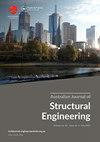Accurate finite element modeling of the mechanical behavior of SS304 across the peak dynamic strain aging temperatures
IF 1.3
Q4 ENGINEERING, CIVIL
Australian Journal of Structural Engineering
Pub Date : 2022-03-01
DOI:10.1080/13287982.2022.2046317
引用次数: 0
Abstract
ABSTRACT Dynamic strain ageing or DSA is exhibited by ferrous and aluminium alloys typically at elevated temperatures and low strain rates. This effect, in association with viscoplasticity, produces a complex material behaviour which is manifested through positive strain rate sensitivity of the flow stress in certain pockets of temperatures and strain rates and negative strain rate sensitivity in others. The conventional material models of DSA either lack the ability to accurately capture the DSA effect or to incorporate the effect of the temperature variation. The objective of this work was to propose a constitutive model which can do both. The desired material model was proposed by performing necessary augmentations to a conventional material model. The suitable conventional model for this purpose was identified through rigorous comparison of the existing models. The proposed constitutive model could accurately capture the DSA behaviour of austenitic stainless steel 304 for different strain rates over a range of temperatures across the peak DSA temperatures.SS304在峰值动态应变时效温度下的力学行为的精确有限元建模
动态应变老化或DSA是铁合金和铝合金在高温和低应变速率下的典型表现。这种效应与粘塑性相结合,产生了一种复杂的材料行为,这种行为表现为在某些温度和应变率的口袋中流动应力的正应变率敏感性和在其他地方的负应变率敏感性。传统的DSA材料模型要么缺乏准确捕捉DSA效应的能力,要么没有考虑温度变化的影响。这项工作的目的是提出一个本构模型,可以做到这两点。通过对传统材料模型进行必要的扩充,提出了所需的材料模型。通过对现有模型的严格比较,确定了适合于此目的的常规模型。所提出的本构模型可以准确地捕捉到奥氏体不锈钢304在不同应变率下的DSA行为。
本文章由计算机程序翻译,如有差异,请以英文原文为准。
求助全文
约1分钟内获得全文
求助全文
来源期刊

Australian Journal of Structural Engineering
ENGINEERING, CIVIL-
CiteScore
2.50
自引率
0.00%
发文量
31
期刊介绍:
The Australian Journal of Structural Engineering (AJSE) is published under the auspices of the Structural College Board of Engineers Australia. It fulfils part of the Board''s mission for Continuing Professional Development. The journal also offers a means for exchange and interaction of scientific and professional issues and technical developments. The journal is open to members and non-members of Engineers Australia. Original papers on research and development (Technical Papers) and professional matters and achievements (Professional Papers) in all areas relevant to the science, art and practice of structural engineering are considered for possible publication. All papers and technical notes are peer-reviewed. The fundamental criterion for acceptance for publication is the intellectual and professional value of the contribution. Occasionally, papers previously published in essentially the same form elsewhere may be considered for publication. In this case acknowledgement to prior publication must be included in a footnote on page one of the manuscript. These papers are peer-reviewed as new submissions. The length of acceptable contributions typically should not exceed 4,000 to 5,000 word equivalents. Longer manuscripts may be considered at the discretion of the Editor. Technical Notes typically should not exceed about 1,000 word equivalents. Discussions on a Paper or Note published in the AJSE are welcomed. Discussions must address significant matters related to the content of a Paper or Technical Note and may include supplementary and critical comments and questions regarding content.
 求助内容:
求助内容: 应助结果提醒方式:
应助结果提醒方式:


